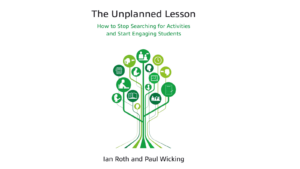by Ken Paterson
Step back a little. Listen to the conversations around you (in any language). You’ll soon be aware of a kind of grammar that adds to, and is sometimes different from, the traditional items we teach in our classrooms.
If the conversation is in English, you may hear a tail: ‘It’s a great place to visit, Edinburgh.’ Or a bit of vague language: ‘Shall we meet at elevenish?’ Or a conversational discourse marker: ‘So I said to him, look, you don’t have to be rude.’
When I first started thinking about this special conversational grammar, my aim was simple: to identify a syllabus of such items, produce some materials (if they didn’t already exist), and teach it.
Corpus research
So I started Googling. Soon I came across the term ‘spoken grammar’, and the work of the corpus linguists Michael McCarthy and Ronald Carter. By computer-processing millions of words of spoken English, they (and others in the same field) identified a number of frequently-used grammatical features that rarely feature in our regular teaching syllabuses. Some of them don’t even have names.
Over the next couple of years, I read everything I could on spoken grammar, making a list of all the items I found. Then I thought: which of these features would actually be useful and learnable in our classrooms? Some, after all, were common examples of ‘dysfluency’: the mistakes we make when we speak, and the ‘repairs’ we put in place. Others might be too regional or colloquial. (How native-like, anyway, do learners want to be?)
Useful and learnable items
In the end, I came up with 18 items that I thought would work well in the classroom, including:
• Heads: ‘That white building, is it the Museum of Contemporary Art?’
• Ellipsis: ‘Want to share a taxi?’
• Response tokens: ‘Brilliant. Perfect.’
• Synonymous language: ‘Awful news, isn’t it? ~ ‘Terrible.’
• Binomial phrases: ‘It’s lovely and warm out here.’
• Vague placeholders: ‘Did you see that thing last night on Somalia?’
For a full list, please visit this page on my website:
https://www.kenpatersonwriter.com/spoken-grammar/
You’ll also find details there of the books and articles I consulted, in case you want to read around the subject yourself.
A list of items, of course, is not much use to students. They need a bit more than that. A guide to usage, at least, and some materials to practise with. Back to the desk, then, for me.
When I had finished producing dialogues, exercises and activities, however, I felt a bit apprehensive. What if I’d been travelling down a pedagogical cul de sac? So I returned to the classroom as quickly as I could, trialling my new materials at the University of Westminster, where I worked at the time. Then I got onto planes and trains, talking to ELT teachers at TESOL Spain and IATEFL conferences. The feedback was encouraging.

In Seville, after a TESOL Spain talk, I met Nick Boisseau of Delta Publishing, and he suggested I try writing a book to get the message across to a wider audience. So I did, asking two colleagues (Caroline Caygill and Rebecca Sewell) to help me produce an explanation-and-practice textbook for students. ‘A Handbook of Spoken Grammar’ was finally published by Delta in 2011, and shortlisted soon after for a British Council ELTon award in the category ‘Innovation in Learner Resources’. (We didn’t win.)
An online course for teachers
So far so good. But I still wanted to go further in the area, talking directly to teachers this time, modelling the pronunciation of key language, and producing flexible exercises and activities for them to use in their own way in the classroom.
An online course, with downloadable materials that teachers could adapt, seemed the best option. I also thought that the time was right to organise my list of spoken grammar items into broader categories. I chose five: word order and ellipsis; emphasis; vague language; marking spoken discourse; and response language. The course was released in November 2018.
If you’d like to see the full curriculum, please visit this page:
Get in touch
Spoken grammar isn’t a revolution in language teaching, but it does give students interesting new choices in their conversation, some of which – ways of using direct rather than reported speech, for example, or vague language that replaces precise lexical choices – can be liberating.
Do let me know (by commenting below) if you’ve ever tried to introduce this kind of language to your students. Some learners, of course, just seem to acquire spoken grammar on their own by listening and speaking. But others, if they’re exposed to naturalistic dialogues, short exercises, role plays, simulations etc. may also be encouraged to add these items to their conversational skills.




